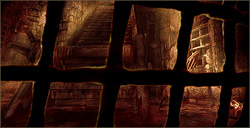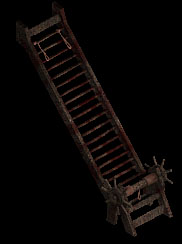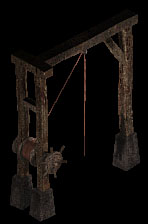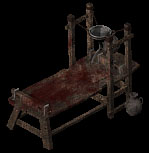Investigation
Inquisitor is a role playing game which means that the main character will travel the game world, communicate with other characters and, of course, fight. The story of the game revolves around an investigation of crimes against God and King. With your main character you will search for clues of dangerous as well as cunning criminals, gather evidence against them and convict them. Accomplishment of most tasks is therefore bound to obtaining a sufficient number of convincing evidences that will allow you to exhibit a charge against a certain character and arrest him or her subsequently. According to the Inquisitorial Codex, anything that can prove the guilt of the suspect may be used as an evidence. Most often it will be testimonies of witnesses and corpus delicti but it can also be for example logical deductions of the main character implied from other, seemingly unrelated information. To make your investigation easier, all of the gathered evidence is written down in a special part of your notebook.
Arrest
 As soon as you manage to gather adequate number of evidence against a certain character you can look up local inquisitorial prosecutor or judge and ask him to issue an arrest order. On the grounds of an issued arrest order you can go and put a suspected character to jail. Characters are arrested by conveying a charge to the suspect. That person will either give in voluntarily, or you will have to overcome his or her resistance using violence. If you succeed and the suspect won’t fight till death a portrait of the arrested person will show up next to the portrait of the main character. Then it is necessary to escort the arrested person to the local sheriff and hand him or her over for imprisonment.
As soon as you manage to gather adequate number of evidence against a certain character you can look up local inquisitorial prosecutor or judge and ask him to issue an arrest order. On the grounds of an issued arrest order you can go and put a suspected character to jail. Characters are arrested by conveying a charge to the suspect. That person will either give in voluntarily, or you will have to overcome his or her resistance using violence. If you succeed and the suspect won’t fight till death a portrait of the arrested person will show up next to the portrait of the main character. Then it is necessary to escort the arrested person to the local sheriff and hand him or her over for imprisonment.
Torture
Torture is an important part of every inquisitorial investigation and you are fully entitled to use it. Therefore you will be able to use four torturing instruments in total in the game to disclose the culprits—a rack, a strappado, a pillory and an iron maiden. However, in connection with torture a notice has to be given—even though the inquisitorial law allows it as a regular way of obtaining a testimony or a confession you should approach its usage cautiously because no one can ever know if a character being questioned is really guilty, and to torture an innocent can socially harm the main character deeply. Moreover, every torture (whether of a guilty or an innocent character) worsens the main character’s alignment. That is why you should always try to avoid the torture by obtaining a needed evidence in another way—but that is not possible in all cases.
Trial
 As soon as you obtain other (convincing) evidence against an arrested person you can pass the whole case on to local inquisitorial judge. After hearing out all of the gathered evidence, the judge will decide whether to impose a trial against the accused or not. If it happens so, you—as a plaintiff’s attorney—will have to bring forward all of the evidence and eventually put in corpus delicti as well with which you will certify the accused person’s guilt. If you don’t have those items at hand, the trial will be adjourned until you will obtain corpus delicti once again. In case you have these items about or if no items are needed to implement evidence, the inquisitorial judge will deliver the verdict of guilty and you will be bound to set the stake on fire.
As soon as you obtain other (convincing) evidence against an arrested person you can pass the whole case on to local inquisitorial judge. After hearing out all of the gathered evidence, the judge will decide whether to impose a trial against the accused or not. If it happens so, you—as a plaintiff’s attorney—will have to bring forward all of the evidence and eventually put in corpus delicti as well with which you will certify the accused person’s guilt. If you don’t have those items at hand, the trial will be adjourned until you will obtain corpus delicti once again. In case you have these items about or if no items are needed to implement evidence, the inquisitorial judge will deliver the verdict of guilty and you will be bound to set the stake on fire.
Torturing instruments:
A rack is a classical torturing instrument where the questioned person is laid on a slant bench and stretched using belts with a winch until his or her limbs dislocate and his or her muscles crackle. |
A strappado is an instrument with which the questioned person’s hands, tied up behind his or her back, are pulled aloft resulting in his or her arms being dislocated in the shoulders thanks to his or her weight. |
|
 |
 |
|
A pillory is a bench equipped with folding planks at both ends with openings for hands, legs and head into which the questioned person is locked and then beaten with stock whip, burnt with iron or choked with water poured into his or her throat. |
An iron maiden is an all-metal torturing instrument in the form of a double wing hollow figurine with spikes on the inside where the questioned person is placed in the middle of the figurine that is then slowly being closed which results in a gradual penetration of iron spikes into the body of the person being interrogated. |
|
 |
 |
